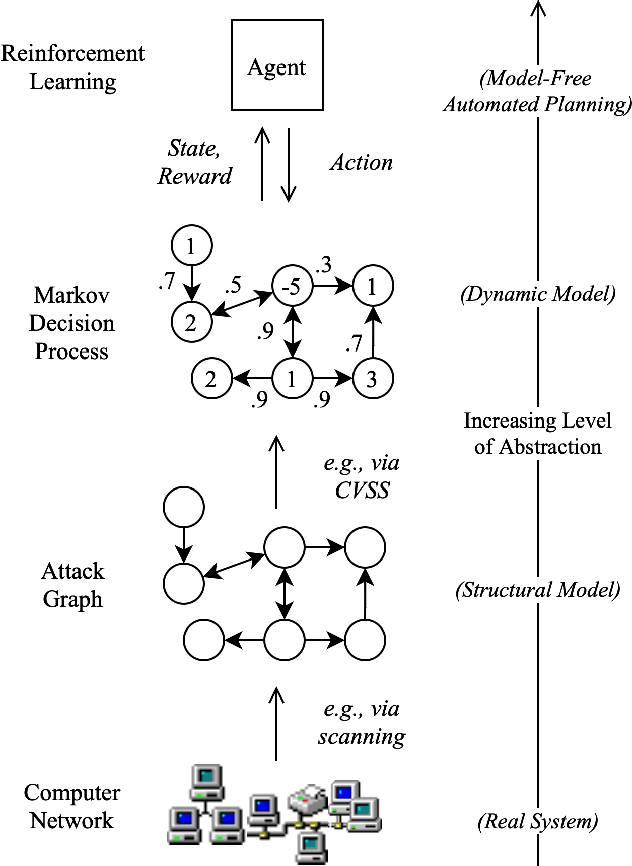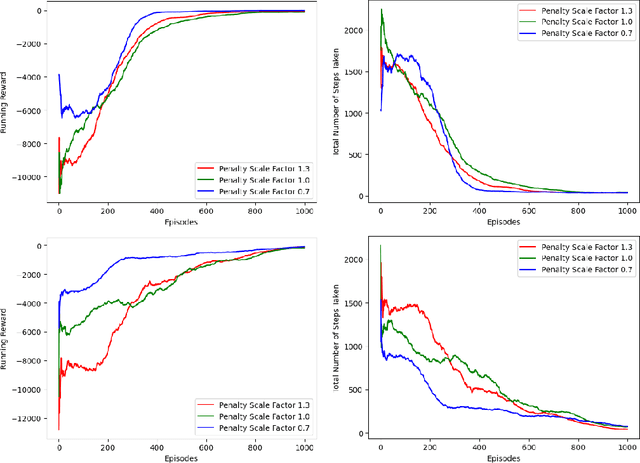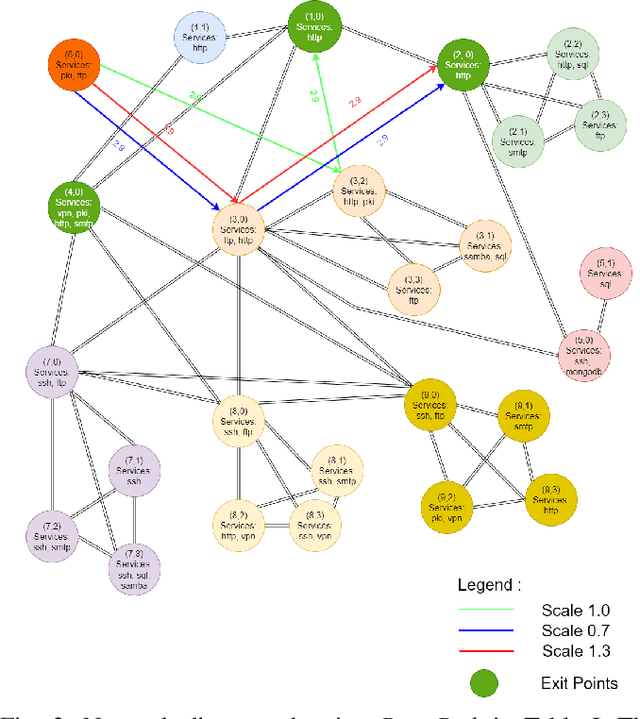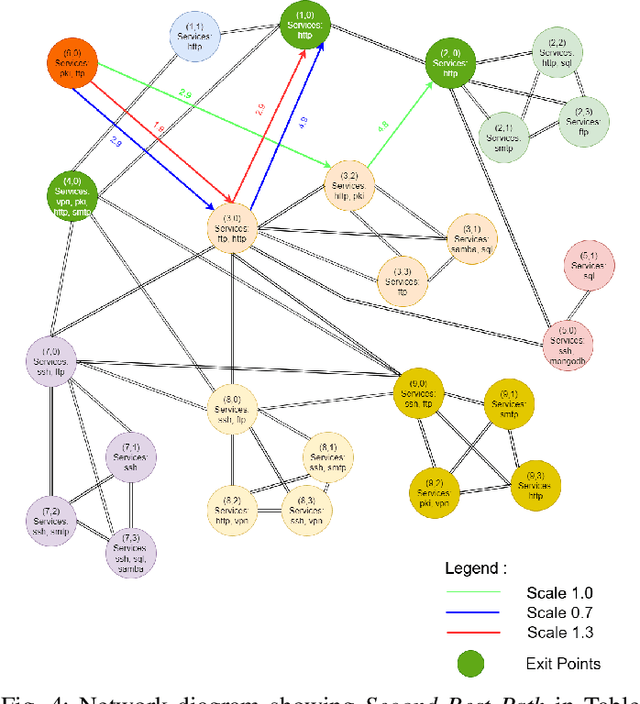Ryan Clark
Leveraging Reinforcement Learning in Red Teaming for Advanced Ransomware Attack Simulations
Jun 25, 2024Abstract:Ransomware presents a significant and increasing threat to individuals and organizations by encrypting their systems and not releasing them until a large fee has been extracted. To bolster preparedness against potential attacks, organizations commonly conduct red teaming exercises, which involve simulated attacks to assess existing security measures. This paper proposes a novel approach utilizing reinforcement learning (RL) to simulate ransomware attacks. By training an RL agent in a simulated environment mirroring real-world networks, effective attack strategies can be learned quickly, significantly streamlining traditional, manual penetration testing processes. The attack pathways revealed by the RL agent can provide valuable insights to the defense team, helping them identify network weak points and develop more resilient defensive measures. Experimental results on a 152-host example network confirm the effectiveness of the proposed approach, demonstrating the RL agent's capability to discover and orchestrate attacks on high-value targets while evading honeyfiles (decoy files strategically placed to detect unauthorized access).
Discovering Command and Control (C2) Channels on Tor and Public Networks Using Reinforcement Learning
Feb 14, 2024Abstract:Command and control (C2) channels are an essential component of many types of cyber attacks, as they enable attackers to remotely control their malware-infected machines and execute harmful actions, such as propagating malicious code across networks, exfiltrating confidential data, or initiating distributed denial of service (DDoS) attacks. Identifying these C2 channels is therefore crucial in helping to mitigate and prevent cyber attacks. However, identifying C2 channels typically involves a manual process, requiring deep knowledge and expertise in cyber operations. In this paper, we propose a reinforcement learning (RL) based approach to automatically emulate C2 attack campaigns using both the normal (public) and the Tor networks. In addition, payload size and network firewalls are configured to simulate real-world attack scenarios. Results on a typical network configuration show that the RL agent can automatically discover resilient C2 attack paths utilizing both Tor-based and conventional communication channels, while also bypassing network firewalls.
Discovering Command and Control Channels Using Reinforcement Learning
Jan 13, 2024



Abstract:Command and control (C2) paths for issuing commands to malware are sometimes the only indicators of its existence within networks. Identifying potential C2 channels is often a manually driven process that involves a deep understanding of cyber tradecraft. Efforts to improve discovery of these channels through using a reinforcement learning (RL) based approach that learns to automatically carry out C2 attack campaigns on large networks, where multiple defense layers are in place serves to drive efficiency for network operators. In this paper, we model C2 traffic flow as a three-stage process and formulate it as a Markov decision process (MDP) with the objective to maximize the number of valuable hosts whose data is exfiltrated. The approach also specifically models payload and defense mechanisms such as firewalls which is a novel contribution. The attack paths learned by the RL agent can in turn help the blue team identify high-priority vulnerabilities and develop improved defense strategies. The method is evaluated on a large network with more than a thousand hosts and the results demonstrate that the agent can effectively learn attack paths while avoiding firewalls.
Exposing Surveillance Detection Routes via Reinforcement Learning, Attack Graphs, and Cyber Terrain
Nov 06, 2022Abstract:Reinforcement learning (RL) operating on attack graphs leveraging cyber terrain principles are used to develop reward and state associated with determination of surveillance detection routes (SDR). This work extends previous efforts on developing RL methods for path analysis within enterprise networks. This work focuses on building SDR where the routes focus on exploring the network services while trying to evade risk. RL is utilized to support the development of these routes by building a reward mechanism that would help in realization of these paths. The RL algorithm is modified to have a novel warm-up phase which decides in the initial exploration which areas of the network are safe to explore based on the rewards and penalty scale factor.
Discovering Exfiltration Paths Using Reinforcement Learning with Attack Graphs
Jan 28, 2022



Abstract:Reinforcement learning (RL), in conjunction with attack graphs and cyber terrain, are used to develop reward and state associated with determination of optimal paths for exfiltration of data in enterprise networks. This work builds on previous crown jewels (CJ) identification that focused on the target goal of computing optimal paths that adversaries may traverse toward compromising CJs or hosts within their proximity. This work inverts the previous CJ approach based on the assumption that data has been stolen and now must be quietly exfiltrated from the network. RL is utilized to support the development of a reward function based on the identification of those paths where adversaries desire reduced detection. Results demonstrate promising performance for a sizable network environment.
Crown Jewels Analysis using Reinforcement Learning with Attack Graphs
Aug 20, 2021



Abstract:Cyber attacks pose existential threats to nations and enterprises. Current practice favors piece-wise analysis using threat-models in the stead of rigorous cyber terrain analysis and intelligence preparation of the battlefield. Automated penetration testing using reinforcement learning offers a new and promising approach for developing methodologies that are driven by network structure and cyber terrain, that can be later interpreted in terms of threat-models, but that are principally network-driven analyses. This paper presents a novel method for crown jewel analysis termed CJA-RL that uses reinforcement learning to identify key terrain and avenues of approach for exploiting crown jewels. In our experiment, CJA-RL identified ideal entry points, choke points, and pivots for exploiting a network with multiple crown jewels, exemplifying how CJA-RL and reinforcement learning for penetration testing generally can benefit computer network operations workflows.
Using Cyber Terrain in Reinforcement Learning for Penetration Testing
Aug 16, 2021



Abstract:Reinforcement learning (RL) has been applied to attack graphs for penetration testing, however, trained agents do not reflect reality because the attack graphs lack operational nuances typically captured within the intelligence preparation of the battlefield (IPB) that include notions of (cyber) terrain. In particular, current practice constructs attack graphs exclusively using the Common Vulnerability Scoring System (CVSS) and its components. We present methods for constructing attack graphs using notions from IPB on cyber terrain analysis of obstacles, avenues of approach, key terrain, observation and fields of fire, and cover and concealment. We demonstrate our methods on an example where firewalls are treated as obstacles and represented in (1) the reward space and (2) the state dynamics. We show that terrain analysis can be used to bring realism to attack graphs for RL.
 Add to Chrome
Add to Chrome Add to Firefox
Add to Firefox Add to Edge
Add to Edge